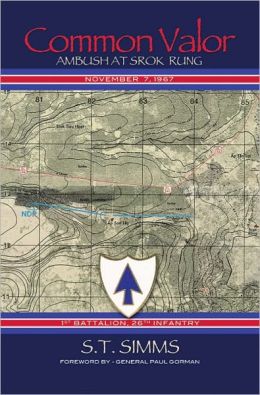Common Valor by S.T. Simms | Books in Review
I spent an entire day reading S.T. Simms’s slim Common Valor: Ambush at Srok Rung, November 7, 1967 (Little Miami, 103 pp., $14. paper), and I ain’t a slow reader. But I read many paragraphs more than once, fascinated by the battle scenes Simms recreated. His topic is the beating taken by the 1st Battalion, 26th Infantry on November 7, 1967, near Srok Rung in South Vietnam.
Steve Simms was there. He talks about his participation, but the day’s drama comes primarily from eyewitness accounts of thirty other soldiers. Simms spent eight years finding and interviewing his fellow soldiers and researching the 1st Infantry Division’s Blue Spade Archives.
On that morning, with Alpha Company in reserve, Charlie and Delta companies of the 1/26 set out to find a North Vietnamese regiment believed to be in the area. The men knew that it would not be as easy day. As Chaplain John Talley, who accompanied them, put it, “Everybody was aware that this could be deep stuff.” Battalion Commander LTC Arthur Stigall reminded the men to travel with their “fingers on the triggers.”
Despite the warnings, that afternoon inside a rubber plantation the Blue Spaders walked into a U-shaped ambush by camouflaged NVA soldiers hidden high in trees and in ground-level brush. With an initial barrage of rocket propelled grenades, the NVA killed the entire 1/26 command element, including Stigall.
Valor was the order of the day for the men of the 1/26. On page after page, Simms describes the intensity with which they fought for their lives. Eighteen Americans were killed and thirty wounded before artillery and airpower drove off the NVA.
For unknown reasons, the Americans did not sweep the battleground or count enemy bodies. They recovered no documents and only a few enemy weapons.
Simms makes a strong case that the ambush never should have happened. He blames it on errors in judgment and training. For example, firepower was not employed early enough as the Americans chased NVA soldiers on foot rather than with artillery, which was waiting to be called. The Americans also failed to deploy cloverleaf patrol and withheld fire because they were unfamiliar with NVA uniforms and thought approaching troops might be ARVN soldiers.
On a broader scale, Simms faults the policy of rotating officers and NCOs between six months of combat and six months of off-line duty. “These policies led to dangerous mediocrity on the battlefield [and] to [poor] tactics, techniques, and procedures, ” Gen. Paul Gorman said.

1st Infantry troops in Vietnam in 1967
Simms looks at the policy of using American troops as “bait” to entice the enemy to battle. Simms and Gorman condone using that tactic in the guise of search-and-destroy missions, noting that it was a good plan when executed properly. But Simms fails to examine how frequently offensive search-and-destroy missions became defensive nightmares as a result of NVA ambushes and countless well-placed booby traps.
Vietnam veterans who write autobiographies about their combat experiences these days tend to give greater recognition to the leadership and fighting skills of the North Vietnamese Army. Common Valor reflects that thinking. Simms notes that the NVA had the advantage of “concealment and surprise” and were “masters at camouflage and tunneling.” He also recognizes their ability to “hold on to the Americans by the belt, ” which “rendered our artillery and air strikes useless.”
Unlike Simms, many writers often overlook the NVA’s fighting experience on their own terrain and their ability to design tactics that neutralized better-armed but less-determined opponents. Additionally, writers often ignore the fact that the NVA fought for posterity; while most Americans fought to survive for a year and return home.
Steve Simms found merit in NVA planning. Every maneuver made by the enemy in October and November of 1967, he says, was designed to help the Tet Offensive succeed a few months later. Attacking Loc Ninh was a rehearsal for the Tet attack on Saigon, seventy miles to the south.
In Simms’ skinny book, the pages are few, and the print is small, but the ideas are huge.
—Henry Zeybel

